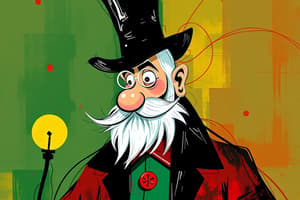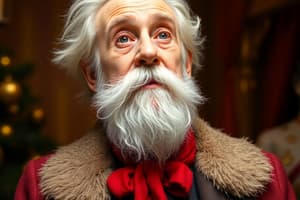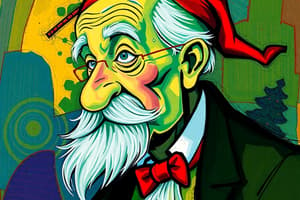Podcast
Questions and Answers
He willingly takes strolls in 'easterly winds' -- he ______ for isolation and misery.
He willingly takes strolls in 'easterly winds' -- he ______ for isolation and misery.
yearns
The cold within him ______ his old features, reinforcing his internal apathy.
The cold within him ______ his old features, reinforcing his internal apathy.
froze
Every inch of Scrooge's being, external and internal, is ______ by his distant attitude.
Every inch of Scrooge's being, external and internal, is ______ by his distant attitude.
tainted
Scrooge is presented as successful in his ______ of himself.
Scrooge is presented as successful in his ______ of himself.
He is ______ by human interaction and affection.
He is ______ by human interaction and affection.
Dickens creates Scrooge as an ______ villain in the context of an impoverished society.
Dickens creates Scrooge as an ______ villain in the context of an impoverished society.
The asyndetic listing of 'squeezing, wrenching, grasping' highlights his ______.
The asyndetic listing of 'squeezing, wrenching, grasping' highlights his ______.
The parallels between Scrooge and the sins are used by Dickens to highlight how the rich are more ______ than the poor.
The parallels between Scrooge and the sins are used by Dickens to highlight how the rich are more ______ than the poor.
Dickens is inverting the idea that the poor are sinners, instead highlighting the rich are more ______.
Dickens is inverting the idea that the poor are sinners, instead highlighting the rich are more ______.
Scrooge struggles to assimilate (blend) into society, creating a struggle for the ______.
Scrooge struggles to assimilate (blend) into society, creating a struggle for the ______.
Scrooge continues to live in a state of ______, neglecting others and not offering to alleviate their suffering.
Scrooge continues to live in a state of ______, neglecting others and not offering to alleviate their suffering.
Scrooge's reaction to the charity men serves as a ______ of the upper classes' relationship with the rest of society.
Scrooge's reaction to the charity men serves as a ______ of the upper classes' relationship with the rest of society.
Scrooge questions why he is morally ______ to give, revealing the Victorian reader's insight into societal responsibilities.
Scrooge questions why he is morally ______ to give, revealing the Victorian reader's insight into societal responsibilities.
His Malthusian ______ are evident when he dismisses the poor as numbers contributing to the 'surplus population'.
His Malthusian ______ are evident when he dismisses the poor as numbers contributing to the 'surplus population'.
The weather acts as a ______ (recurring symbol) throughout the novella, changing alongside Scrooge.
The weather acts as a ______ (recurring symbol) throughout the novella, changing alongside Scrooge.
Dickens employs pathetic ______ by depicting the setting with 'fog and darkness thickened' to mirror Scrooge’s bleakness.
Dickens employs pathetic ______ by depicting the setting with 'fog and darkness thickened' to mirror Scrooge’s bleakness.
Flashcards are hidden until you start studying
Study Notes
Scrooge's Character
- Scrooge is presented as a solitary figure who actively seeks isolation and misery. His desire to remain detached extends so deeply that it even impacts how he appears physically.
- Scrooge represents the immoral and greedy upper class in Victorian England. The author criticizes the social injustice prevalent during this time.
- Scrooge's self-imposed isolation is highlighted by his aversion to human interaction and affection. This sets the stage for his encounter with the spirits, meant to alert him to the consequences of his actions.
Social Commentary
- Scrooge's aversion to charity and his questioning of the morality of giving reflect the upper class's detachment from the struggles faced by the poor in Victorian society.
- Dickens uses a satirical approach to expose the perceived hypocrisy of the upper class by portraying them as more sinful than the poor. This challenges the prevailing view that poverty is a result of laziness.
- Scrooge's Malthusian beliefs, evident in his reference to prisons and workhouses, highlight the dehumanizing perception of the poor as surplus population.
Setting and Symbolism
- The weather serves as a symbolic motif throughout the novella, reflecting Scrooge's emotional state. Dickens employs pathetic fallacy, where the bleakness of the setting mirrors Scrooge's internal desolation.
- The fog in London during the late 1800s serves as a contextual reference, highlighting the deadly impact of environmental factors on the population. Dickens may be drawing a parallel between the weather and the power of the rich to inflict suffering.
- The personification of the weather, particularly the cold described as "piercing" and "biting," foreshadows the supernatural elements that will influence Scrooge's transformation.
Studying That Suits You
Use AI to generate personalized quizzes and flashcards to suit your learning preferences.




